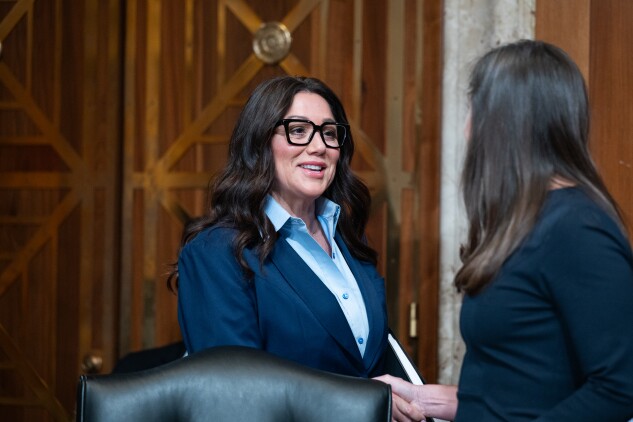Monday Morning Musings for Workplace Watchers
LCD Meets Business | Re-imagining the NLRB
Rebecca Rainey: Lori Chavez-DeRemer’s first two months as labor secretary were packed with at least 29 meetings with business leaders and trade associations, 16 with unions and worker advocates, and at least five road trips, according to a review of her public schedule.
The labor secretary’s calendars for March and April, which were released last week, included meetings with United Parcel Service CEO Carol Tomé, Uber CEO Dara Khosrowshahi, AFL-CIO President Liz Shuler, and the National Employment Law Project.
Her first official meeting—outside of DOL staff—was with CEO Kristin Sharp of Flex Association, a group that represents app-based companies including Uber and Lyft.
Chavez-DeRemer’s schedule also included a weekly check-in with the Department of Government Efficiency.
The public schedule provides a snapshot of the labor secretary’s plans, but they don’t include a full accounting of her meetings and work. Chavez-DeRemer’s calendars do suggest she plans to take on a public-facing role as a road warrior for President Donald Trump’s agenda, similar to the styles of former Biden Secretaries Marty Walsh and Julie Su.
Chavez-DeRemer launched her nationwide “America at Work” listening tour in April to learn more about issues impacting workers and businesses to inform DOL policymaking. So far, over the past two months she’s traveled to California, Nevada, Pennsylvania, Florida, and Oregon in her first two months on the job.
She met with Oregon Democrat Gov. Tina Kotek in April when visiting the state, where she toured Daimler Truck North America and an Ironworkers Union project labor agreement-covered high school construction site.
She also had speaking gigs at both the Teamsters Unity Conference and the North America’s Building Trades Unions Legislative Conference in April.
However, the amount of time labor secretaries have spent on the road has been the subject of past Republican scrutiny. Rep. Virginia Foxx (R-N.C.) frequently criticized Walsh’s “evident aversion to conducting his work in Washington,” and often grilled the DOL for his public schedules.
Robert Iafolla: While the Trump administration is trying to limit the National Labor Relations Board’s independence from the White House, a veteran management-side labor lawyer hopes that effort could, in a roundabout way, preserve its autonomy.
Roger King said he’s worked on a proposal to restructure the agency long before Trump’s unprecedented termination of NLRB member Gwynne Wilcox sparked a legal battle that’s working its way to the US Supreme Court.
“It will take some urgent need to act for this proposal to be given serious consideration,” said King, senior counsel at HR Policy Association. “Given the pendency of the Wilcox litigation and the direction that the Supreme Court has signaled it will take, there may be some urgency this coming fall.”
King unveiled a proposal last week that advocates for replacing the board with a labor court of judges insulated from at-will removal by the president.
That protection would come from the labor court being created by Congress under Article I of the Constitution and acting as a purely adjudicatory body, according to the plan King developed with New York University law professor Samuel Estreicher and Cornell University law professor David Sherwyn.
The Trump administration’s primary argument for why Wilcox’s for-cause removal protections are invalid is that NLRB members exercise significant executive authority. The Supreme Court gave its preliminary endorsement of that theory in a recent decision that blocked a lower court’s order for Wilcox’s reinstatement.
The proposal to reboot the NLRB also aims to increase the stability of federal labor law by changing the partisan dynamic that’s driven flip-flopping board precedents.
Rather than a five-member board with partisan control changing hands depending on who occupies the White House, the labor court would have six judges: two Democrats, two Republicans, and two independents.
The plan does appear to have some blind spots, though, lacking clear answers for other emerging problems that threaten the NLRB’s ability to shape labor law policy.
For example, it calls for a quorum of four judges—including at least one independent—but doesn’t protect against a president hamstringing the agency by not appointing enough judges for the labor court to function.
King said he’ll continue to vet the proposal with stakeholders and meet with people on Capitol Hill.
“At a minimum,” he said, “our proposal will initiate serious discussion and debate about the future of the National Labor Relations Board.”
We’re punching out. Daily Labor Report subscribers please check in for updates during the week, and feel free to reach out to us.
To contact the reporters on this story:
To contact the editors responsible for this story:
Learn more about Bloomberg Law or Log In to keep reading:
See Breaking News in Context
Bloomberg Law provides trusted coverage of current events enhanced with legal analysis.
Already a subscriber?
Log in to keep reading or access research tools and resources.



